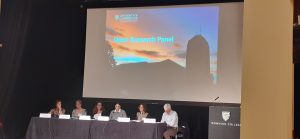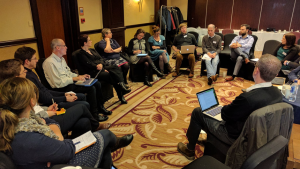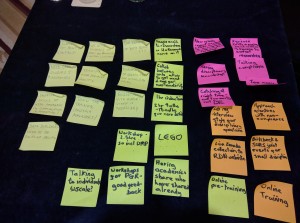In preparation for our the “Electronic Lab Notebooks: Solutions for Paperless Research” we decided to re-blog this post* on the subject written by Niamh Tumelty, Head of STEM Libraries at the University of Cambridge.
Roundtable on Electronic Laboratory Notebooks
A significant part of my role involves research support, but so far I have not been involved with lab notebooks, electronic or otherwise. I registered for this session at the Special Libraries Association meeting in 2014 mainly out of curiosity, hoping to find out more about what products others are using, how they’re finding them and whether or not they would be of interest to my Department.
What is an ELN?
Simon Coles set the scene with an overview of the development of electronic lab notebooks (ELNs) to date and frank assessment of their value in different contexts. Simon has been working on developing ELNs since 1996 and has been with for Amphora for 11 years. Amphora identified three problems to solve: capturing information from busy scientists, preserving data in complex contexts and being able to provide evidence in court, for example to prove the origin of an idea. They work with a wide range of customers with some of the largest and smallest implementations of electronic lab notebooks.
There is no single definition of ELN so we look carefully at what we need. We need to be wary of what exactly was meant by other case studies, since what they implemented may not be relevant or comparable at all. Researchers naturally expect that lab notebooks would be tailored to their research workflows, and since there are very different workflows in different areas of science it is unlikely that one solution will be appropriate for an entire organisation.
Another key point is that an ELN doesn’t have to be a complex purchased product. MS Word and WordPress have been successfully used and there is a real danger of finding yourself in ‘consulting heaven’ with some of the commercial products, with costly ongoing support turning out to be essential. If introducing an ELN we need to consider a number of questions:
- Do we want it to be about record-keeping and collaboration or is it about doing bits of science?
- Does it need to enforce certain processes?
- Is it something specific to a group of scientists or generic (bearing in mind that even the same scientist’s needs will change over time)?
- How large and diverse is your user base?
The university view
Daureen Nesdill is Data Curation Librarian at the University of Utah and has been involved with the USTAR project. They conducted a study on campus to see what was already happening in terms of ELNs and found that they were already being used in some areas (including in the Humanities) and one person already had a standalone implementation of CambridgeSoft. Daureen set up a Libguide on ELNs to share information about them.
A working group was set up to look more closely at the options but they haven’t implemented a solution campus-wide because no one tool will work for the whole campus. Other barriers include the expense of acquiring an ELN (purchasing software, local hosting and support or cloud hosting), the question of who pays for this and the amount of time it takes to roll out (a few months for a lab of 50 people!) There are also concerns about security, import-export loss and if using a cloud solution, awareness of where your data is being stored.
Daureen outlined a number of requirements for an ELN in a University:
- ability to control access at an individual level;
- recording of provenance (all needs to be documented in case there is any future question of who did the work) and this information needs to be included in data exports;
- Both cloud and client-based with syncing
- Compatible with any platform
- No chemistry stuff as standard features, instead templates available for all subject areas – let researcher select tools for their research!
- Education pricing for classroom use
- Assistance with addressing complex research protocols
- Integration with mouse colony management system
- Connectors – get data from any equipment used to flow easily into the ELN and out of it into the institutional repository
- Messaging system to allow quick communication between collaborators
- Reminders for PIs to check work of team
- Integrated domain-specific metadata
Corporate perspective
Denise Callihan from PPG Industries provided the corporate perspective. Her company has looked at options for ELNs every five years since the 1980s because their researchers were finding paper lab notebooks were time-consuming and inconvenient. They needed to be able to provide research support for patent purposes to make sure researchers were following the procedures required.
A committee was formed to identify the requirements of three disparate groups: IT and records management, legal and IP, and researchers. A pilot started in 2005 with ten research scientists using Amphora PatentSafe, some in favour of the introduction of ELNs and some against. PPG Industries were early adopters of Amphora PatentSafe so the vendor was very responsive to issues that were arising. The roll-out was managed by researchers, department by department, with the library providing support and administration. Adoption was initially voluntary, then encouraged and is now mandatory for all researchers.
The implementation has been successful and researchers have found that the ELN is easy to use and works with their existing workflows. Amphora PatentSafe uses a virtual printer driver to create searchable notebook pages – anything that can be printed can be imported into the ELN. Email alerting helps them keep track of when they need to sign or witness documents, speeding up this part of the process. The ELN simplifies information sharing and collaboration and eliminates size constraints on documents. It is set up for long-term storage and reduces risks associated with researchers managing this individually. Data visualisation and reporting are built in so it’s easy to see how research is progressing and to check document submission rates when necessary.
PPG Industries found that researchers need to be looking for an ELN solution rather than feeling that one is being imposed on them. Strong support was required from leadership, along with a clear understanding of what drives the need for the ELN. The product they’ve selected focuses on providing an electronic version of the print notebook, but the raw data still needs to be kept separately for future use.
Wrap up
Overall I found this session extremely useful and I now feel much better informed about electronic lab notebooks. I really appreciated the fact that this session, like others at SLA, presented a balanced view of the issues around electronic lab notebooks, with speakers representing vendors, corporate librarians and academic librarians. I now plan to investigate some of the ELN options further so that I am in a position to support possible future implementations of ELNs, but I will wait until the researchers express their need for one rather than suggesting that the Department considers rolling on out across the board.
*Originally published in 2014 at Sci-Tech News, 68(3), 26–28


 Having presented our respective plans to the RDM Forum (
Having presented our respective plans to the RDM Forum ( There are two solutions to this problem which were mentioned during the breakout session. Firstly, some people are using a ‘train the trainer’ approach to involve other research support staff who are based in departments and already have regular contact with researchers. These people can act as intermediaries and are likely to have a good awareness of the discipline-specific issues which the researchers they support will be interested in.
There are two solutions to this problem which were mentioned during the breakout session. Firstly, some people are using a ‘train the trainer’ approach to involve other research support staff who are based in departments and already have regular contact with researchers. These people can act as intermediaries and are likely to have a good awareness of the discipline-specific issues which the researchers they support will be interested in.